The post Seeking The Final Frontier In Palawan appeared first on The Expeditioner Travel Site.
]]>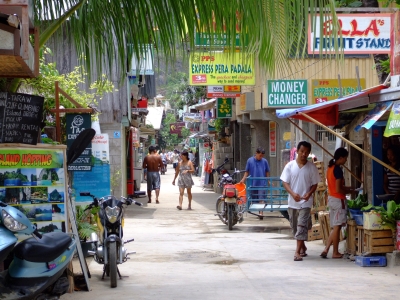
The silver rays of the rising sun creep between the limestone outcrops that dominate the tiny bay; darkness divides into long shadows that slide back up the dampened sands. Beneath the arching palms, all is harmonious. Then the peace of my wood cabin is shattered by an almighty clatter of corrugated iron and a banging of bars — my neighbors are awake. Far from being annoyed at the rude rousing, I can’t wait to go and see them. After all, it’s not every day you wake up next to a monkey enclosure.
I’d arrived two days previously in Palawan, the 15,000-square-kilometer island often referred to as the Philippines’ final frontier (although a country comprising 7,000-plus islands surely has countless uncharted corners). Finding little to detain me in the main town of Puerto Princesa — a concrete tangle of underlit and blaringly noisy streets — I board an air-conditioned minibus bound for the putative paradise of El Nido.
The journey runs smoothly until the road roughens and a rear tire bursts, leaving the dozen passengers — young backpackers from Europe, the U.S. and Canada — stranded under a baking midday sun, squinting around at the unrelenting jungle interior. The spare thankfully installed, we arrive after six long and winding hours to find our bags, strapped to the roof, white with dust. This place had better be worth it, I think grumpily.
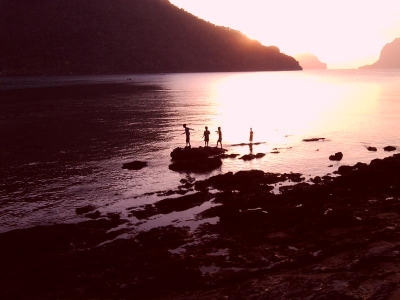 A few hours later in a bamboo beach bar lit by flaming torches, sipping a bottle of Red Horse and drinking in the crimson twilight enveloping the Bacuit Archipelago, the wearing journey is dissolving into the lapping tide. Even when the power supply cuts on cue at 7 p.m., generators keep the Bob Marley backing track flowing. The sun sinks, only to be replaced by the illumination of thousands of candles, carried by locals forming a parade through the silent streets. It’s Good Friday and in this largely Catholic country, they are hauntingly enacting the Stations of the Cross, effigies swaying on pickup trucks.
A few hours later in a bamboo beach bar lit by flaming torches, sipping a bottle of Red Horse and drinking in the crimson twilight enveloping the Bacuit Archipelago, the wearing journey is dissolving into the lapping tide. Even when the power supply cuts on cue at 7 p.m., generators keep the Bob Marley backing track flowing. The sun sinks, only to be replaced by the illumination of thousands of candles, carried by locals forming a parade through the silent streets. It’s Good Friday and in this largely Catholic country, they are hauntingly enacting the Stations of the Cross, effigies swaying on pickup trucks.
Settling down for the night, my window frames the brooding bulk of Cadlao Island across the bay, the stillness dense enough to carry the melodious sound of countless crabs picking over the rocks. A tuko lizard nearby clicks and croaks as a solitary firefly traces loops under a purple dome blazing with more constellations than I knew existed. Just as I’m thinking that this could be perfection, a falling star blazes its signature across the picture. A day that started inauspiciously has yielded one of my most cherishable travel experiences.
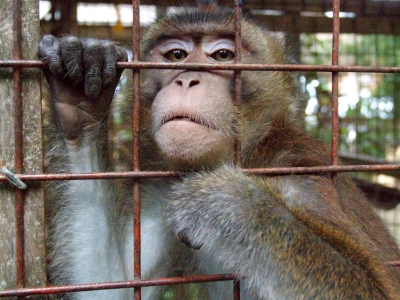 Next morning I’ve got monkey business to attend to. The great attraction of staying at the Golden Monkey Cottages — a 10-minute stroll around the bay — is the chance to get familiar with half a dozen long-tailed macaques. When I returned last night they’d been “roosting” in the gloom since sunset, but in the hazy dawn light, having rattled me awake, I find them leaping around with feral energy, as curious about the newcomer as I am about them.
Next morning I’ve got monkey business to attend to. The great attraction of staying at the Golden Monkey Cottages — a 10-minute stroll around the bay — is the chance to get familiar with half a dozen long-tailed macaques. When I returned last night they’d been “roosting” in the gloom since sunset, but in the hazy dawn light, having rattled me awake, I find them leaping around with feral energy, as curious about the newcomer as I am about them.
The eight comfortably rustic cottages are the handiwork of British owner Kevin McCabe and his Filipina wife Rose. After settling in El Nido six years ago, they adopted a neighbor’s chained-up monkey as a pet, but soon noticed many more unfortunate animals trapped on distressingly short leashes as “mascots” outside local bars or restaurants (an odious practice likely to continue, despite my complaints to the tourist board). When the acquisitions mounted — they had soon rescued a dozen macaques — Kevin applied his 25 years of carpentry experience to building, there amid the cottages, an ingenious enclosure of partitioned anterooms opening onto a main area networked with ropes, poles and branches.
Whatever he lacks in animal care expertise, he more than compensates for in his obvious compassion for the creatures. Besides, it doesn’t take a naturalist to see that their behavior revolves around status. As we hand them their morning bananas and star apples, it’s clear that even with plenty to go around, the macaques would rather fight over food. They will thoughtfully examine everything within reach and apply themselves doggedly to problems — such as breaking out. They once cracked a rusty lock, only to be enticed back, rather too easily, with a handful of their favourite delicacy, pumpkin seeds.
Kevin stresses that this is not a zoo: His sole objective is to return the macaques to their rightful environment. He advises guests not get too close or annoy them by laughing, but it’s hard not to smile at their high-speed horseplay. Pancho and Seamus, two of the lower-ranked soldiers, make lightning grabs at my clothing. Lefty, who bosses the compound with alpha aggression, claws away the sand beneath his feet, apparently planning a tunnel, and sharp-eyed Pepe triumphantly chews a pen he pilfers from my pocket. Sweetie, at two years the baby of the group, sucks her thumb and is bottle fed daily; she slept with Rose and Kevin for a year after being acquired, and would wake them by prying their eyelids open. Mimi, another female, hisses jealously at any passing women. What we are looking at, of course, is human behavior stripped of the subtlety and social niceties. It’s endlessly watchable.
Tearing myself away to explore the town, I learn that until recently El Nido (“the nest” in Spanish) was a backwater community subsisting on a centuries-old trade in bird’s nest soup. The calcium-rich delicacy, made from the saliva nests of the tiny balinsasayaw swiftlets that inhabit caves throughout the archipelago, is highly prized in China where it is believed to improve everything from the digestion to the libido. A kilo of nests can command several thousand dollars; hence the stories of armed guards at cave entrances.
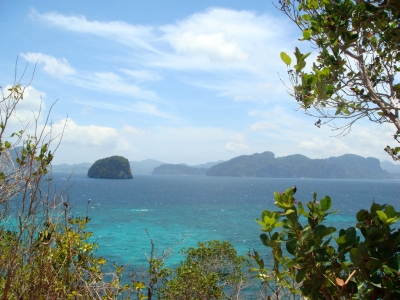 For a closer view of the 45 Bacuit islands, I join a traditional bangka tour. Defying its spluttering engine, our captain Peton guides the outrigger to Pinagbuyutan Island for snorkeling before we clamber through Cadugnon Cave, have lunch at the Snake Island sandbar, pay our respects at the hallowed Cathedral Cave and finally wash up on the powdery-sand paradise of Pangalusian Island. Next day, I immerse myself in some scuba with the superbly organized Submariner Diving School.
For a closer view of the 45 Bacuit islands, I join a traditional bangka tour. Defying its spluttering engine, our captain Peton guides the outrigger to Pinagbuyutan Island for snorkeling before we clamber through Cadugnon Cave, have lunch at the Snake Island sandbar, pay our respects at the hallowed Cathedral Cave and finally wash up on the powdery-sand paradise of Pangalusian Island. Next day, I immerse myself in some scuba with the superbly organized Submariner Diving School.
Until three years ago, only a handful of travelers each year would discover such pleasures. The transformation came with a documentary by a French film crew; already there are some 200 beds in town. Stylish beachfront cafes and eateries are suddenly swallowing the beach, their pseudo-hippie ambiance — artful melanges of lime green walls, shaggy rugs, nara wood tables and organic menus — exerting a magnetic pull on daily busloads of henna-tattooed backpackers and wealthy Manileros.
The pace of development is also impacting on the locals; many families may regret selling their land cheaply (albeit willingly) to foreign investors. A few steps back from the fan-cooled idyll of the waterfront, the harsh economic realities of the rural Philippines remain apparent: A man sprawls drunk in the dust in broad daylight, a family has a furious public row, brandishing sticks at one another, a three-year-old boy tries to wrestle one of the family chickens from the jaws of a wild dog. The changes have benefited many, but also created parallel worlds of transient ease and seemingly permanent hardship.
Back on the sunny side of the line, six little faces await me expectantly, pleading with their eyes to help them escape their surroundings. Little do they know I’d gladly swap places with them and stick around a good while longer.

About the Author
 Carl Thompson has been writing for travel publications and guidebooks for many years, mainly with the intention of avoiding a proper job. For the full story of a misspent decade, please visit UKTravelWriter.co.uk.
Carl Thompson has been writing for travel publications and guidebooks for many years, mainly with the intention of avoiding a proper job. For the full story of a misspent decade, please visit UKTravelWriter.co.uk.
The post Seeking The Final Frontier In Palawan appeared first on The Expeditioner Travel Site.
]]>The post The Day I Spent Teaching In The Philippines (Without Any Warning) appeared first on The Expeditioner Travel Site.
]]>
What does one do when thrust into the unexpected situation of teaching a class of 57 children in the capital of the Philippines? Why, sing, of course.
A trip to the Philippines is always an education, but this time I’d planned on taking things easy. Rather than sail out into the wilderness and explore some of the 7,000-plus islands that make up the archipelago, the idea was simply to stay put in the capital, visit some friends, grab a few bargains in the vast malls and generally avoid the unusually harsh European winter.
It isn’t long, however, before I’m tempted out of my 35th-floor hideaway in the grandly named Global City district of Manila (once the site of a vast American military base called Fort Bonifacio, today it is an upmarket assemblage of corporate skyscrapers, plush apartments and overpriced restaurants) and into the altogether wilder environs of neighboring Taguig.
I hand the taxi driver a piece of paper with the scrawled address of the Captain Jose Cardones Elementary School — where I’m meeting a friend — and he assures me he knows exactly where to go. Soon he’s stopping every few minutes, thrusting the note at every other pedestrian, “just to check, sir.” Meanwhile I sit helplessly in the back, watching the meter tick up and wondering why I still fall for this trick after so many years.
 Mind you, I can understand his confusion. Taguig is a maze of ramshackle markets, makeshift eateries and tiny sari-sari stores, where men in string vests and baseball caps reach between rusting iron bars to make micro-purchases of Nescafe sachets and rough local cigarettes (sold singly, rarely by the packet). A welcome, cool breeze is doing its best to disperse the ever-present fog of pollution, and it seems like the entire city is outside, haggling for vegetables, chewing on chicken kebabs, playing tongits to win a few pesos, or somehow sleeping through the din of traffic and the warbling efforts of unselfconscious videoke singers. The shiny saloons of Bonifacio are gone, outmaneuvered by overloaded tricycle sidecars buzzing down the narrow lanes, causing scrawny dogs to leap for their lives.
Mind you, I can understand his confusion. Taguig is a maze of ramshackle markets, makeshift eateries and tiny sari-sari stores, where men in string vests and baseball caps reach between rusting iron bars to make micro-purchases of Nescafe sachets and rough local cigarettes (sold singly, rarely by the packet). A welcome, cool breeze is doing its best to disperse the ever-present fog of pollution, and it seems like the entire city is outside, haggling for vegetables, chewing on chicken kebabs, playing tongits to win a few pesos, or somehow sleeping through the din of traffic and the warbling efforts of unselfconscious videoke singers. The shiny saloons of Bonifacio are gone, outmaneuvered by overloaded tricycle sidecars buzzing down the narrow lanes, causing scrawny dogs to leap for their lives.
As we pull up in a cloud of dust, I briefly wonder whether the taxi driver will ever find his way out again. Then every head in the street is turning magnetically towards me; very few foreigners have cause to come here. Fedila, an old friend who happens to be an English teacher at the school, is waiting to greet me at the gates. Her daughter is currently in a music class; before we go to dinner, would I care to sit in?
As we make our way along the shiny stone corridors, passing a compact clinic, computer room and library, I hear the first excited cries of “Americano!” from kids who have spotted a visitor through the slatted glass windows of their classrooms. There would be little sense in pointing out that I’m from England, actually (numerous previous trips to the Philippines have taught me that in this country, if you’re white, you’re an Americano — end of story)
Soon we reach the music room where Mrs. Chonchita Savedra is teaching a new song to a class of first-graders. There’s a quick exchange in tagalog — a language spoken by about 22 million Filipinos — of which I understand little, but from the frequent glances and nods in my direction, I sense something is being agreed. Then Fedila disappears, thanking me somewhat cryptically for “helping out.” What, exactly, am I helping out with, I wondered?
“This is Carl, he’s my new boyfriend,” says Chonchita, getting a big laugh from the class, whose lesson has just taken a very unexpected turn. “We’re very lucky to have him with us today. He’s going to teach you all some English songs. Carl, over to you.” And with that she scoops up a stack of exercises books and marches off to catch up on some grading, leaving me with a lot of eager five-year-olds and no idea what to say to them.
It’s hard to say what comes as the bigger shock: the fact of finding myself in front of a class for the first time in 20 years (I once taught English, rather ineptly, to Italian language students during university holidays), or the mortifying prospect of singing in public. There’s no time to dwell on that, though, with 57 expectant faces studying me intently as my mouth opens and closes like a goldfish. Instead I play for time, dredging up a couple of long-forgotten name games and finding out what some of them want to be when they grow up (doctors, astronauts and soldiers mostly).
As I’m going through this routine, some animal pictures on the wall catch my eye, and the old standby, “Old MacDonald Had a Farm” springs to mind. I ask them to list some animals for our farm, expecting them to come up with the usual: cows, pigs and sheep. Instead they call out monkeys, flying foxes and water buffalo — a menagerie not many kids from the West would recognize. After a boisterous rendition, complete with all the right noises, we’re on to “Once I Caught a Fish Alive,” providing an opportunity to practice counting and past tenses.
Just as I’m getting into my stride, Mrs. Savedra comes back, having finished her grading. There’s just time to take a group photo of my five dozen new best friends. As I’m saying my goodbyes, some of them press the back of my hand to their forehead in the pagmamano gesture of respect. Then I’m being ushered along, like some visiting dignitary, to the principal’s office.
As one of her colleagues places a plate of pork adobo in front of me, Rebecca fills me in on the bigger picture: 3,230 children aged between six and eleven are enrolled at Jose Cardones. With 75 teachers to look after them, they attend in two shifts of 6 a.m. to noon and noon to 6 p.m. All of their teachers are female (which accounts for their animation in meeting not just a foreigner, but a man to boot). The curriculum encompasses tagalog, English, math, social studies, science, music, religion, home economics and physical exercise. Thanks to a recent and enlightened government “Education for All” initiative, basic primary tuition is free. In a relatively deprived neighborhood like Taguig, though, many parents struggle to afford the miscellaneous charges for books, packed lunches, uniforms and so forth, and all too frequently, a child halfway through his or her school career will be taken home when the money runs out.
Those fortunate enough to attend benefit from a clear code of conduct, spelled out on posters around the classrooms: “Be Helpful”, “Respect Your Parents and Elders”, “Love Your Country” (“Lupang Hinirang,” the national anthem, is solemnly sung, hand on heart, at the start and end of every week). Other placards instruct the reader to “Worship the Lord Jesus,” and (my favorite) “Obey Signs Such as Keep Off the Grass.” I’m still wondering where this fabled patch of grass might be in the concrete capital.
The school day over, and it is with some reluctance that I head back out through the teeming alleys of Taguig towards the posh end of town. The real life of the city, I now realize, is going on down here, not up in my air-conditioned bubble. Even as a grown man, an afternoon in a children’s class has certainly taught me a thing or two.

About the Author
 Carl Thompson has been writing for travel publications and guidebooks for many years, mainly with the intention of avoiding a proper job. For the full story of a misspent decade, please visit UKTravelWriter.co.uk.
Carl Thompson has been writing for travel publications and guidebooks for many years, mainly with the intention of avoiding a proper job. For the full story of a misspent decade, please visit UKTravelWriter.co.uk.
The post The Day I Spent Teaching In The Philippines (Without Any Warning) appeared first on The Expeditioner Travel Site.
]]>The post Experiencing Norway’s Winter Sports And Living To Tell About It (Barely) appeared first on The Expeditioner Travel Site.
]]>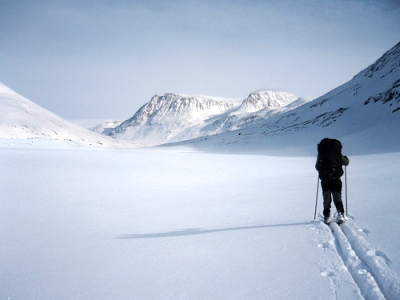
What do you get when you mix dog sledding, .22 rifles, and Norway’s most famous liquor? How about an unforgettable weekend experiencing the best of Norway’s winter sports.
Emerging onto a 3,000-foot plateau in central Norway, the moment freezes. To the east, hundreds of miles of virgin tracks glide enticingly away through the countless conifers of Rondane National Park; to the west, the Scandinavian sun melts over the darkening domes of the Jotunheimen range, its last watery rays hinting at the promise of adventure through drifting clusters of snowflakes. The snow tires of the minibus spin on the icy road, and I can’t wait to get out there. True, I’ve never tried cross-country skiing before, but putting one foot in front of the other can’t be that hard, can it? Before this trip is over, I will rue my overconfidence.
For now, though, a welcome hot drink by a log fire awaits back at the hotel. It’s there we meet our hosts and instructors for the next few days: Nick, a languidly composed former Infantry officer and highly qualified ski instructor; Tony, a clipped and courteous ex-Royal Marines officer; and Pat, a serious mountain man even by the admission of his hugely experienced colleagues. Between them they total nearly a century of military service, not to mention expertise in teaching leadership and organizing expeditions to such forbidding places as Antarctica, South Georgia and Everest. Nordic Challenge, the company formed by Nick and Tony in 2003, aims to give guests of all shapes, sizes and ages the distilled benefit of this vast know-how.
In the morning, after a buffet breakfast worth coming for in itself, there are chores to be tackled before we can hit the tracks. First it’s necessary to select the right clothes: light layers of absorbent and breathable fabrics, followed by just the right kind of ski wax for the conditions. All that’s needed then is a pair of slipper-like boots that click into the skinny skis at the toe only, allowing the heels to lift and making it possible to ski uphill as well as down. Fully equipped, we’re ready to kick out into the wild whiteness.
At first the going is good. All we’re asked to do is slot our skis into inches-deep railtracks carved by a snowplow, and shuffle forwards. Then Nick informs us that we haven’t actually started yet. The trick to this kind of skiing is to “jog” along, keeping the center of gravity low, flinging out the sticks to the rear, and transferring your weight squarely from foot to foot and letting the skis slide. It’s a lot to remember, and getting the knack entails much flailing around like a tortoise on its back, not to mention a conscious effort to ignore apple-cheeked Norwegian children swishing past with innate poise. When the timing comes together, though, the sense of oneness with the Christmas-card surroundings is as thrillingly clear as the Nordic air.
Before long, the effort needed to keep the skis parallel leaves me puffing. Thickening snowfall is filling in the tracks and the spray of powder is swirling on the breeze. It’s time to flop, with cheeks burning, in a ridiculously cozy log cabin complete with open fire, and get to know the seven other members of my group. One of them, an “author and eccentric” called Sue, turns out to be a retired policewoman-turned-shepherdess living a hardy, isolated life in the North of England; another, Andrew, is a rugby player hoping not to fall on his oft-injured shoulder. Then there’s Vena, a budding novelist and keen swimmer (who’s already done 30 lengths of the hotel pool early that morning), and Claire, a sociable specialist in strategic marketing and self-styled couch potato; she definitely wasn’t in the pool at dawn.
Whether it’s the tingling mountain air, or the superbly sugary hot chocolate and waffles, everyone’s on a rarefied high and ready for anything — which is just as well, for with military precision, our hosts are outlining some optional activities for us to sample. The first of these, dog sledding, involves yoking together half a dozen raring-to-run Alaskan huskies, stepping up onto the back runners of your sled, hoisting the ice anchor and whisking off in convoy around a circular course. I quickly master the rubber footplate that curbs the dogs’ progress (or so I think) and soon I’m nurturing fantasies of triumphant Polar expeditions, even as we round a tight turn and my 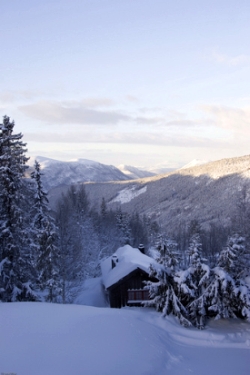 stabilizing leg sinks up to the waist, capsizing the sled and tipping out my passenger, the unfortunate Claire, head-first. For a few long minutes we’re in deep snow, so to speak, with the dogs still surging ahead and Claire buried upside down. I feel a bit ungallant about leaving her like that, but the golden rule, we were told, is to “never let go of the sledge.”
stabilizing leg sinks up to the waist, capsizing the sled and tipping out my passenger, the unfortunate Claire, head-first. For a few long minutes we’re in deep snow, so to speak, with the dogs still surging ahead and Claire buried upside down. I feel a bit ungallant about leaving her like that, but the golden rule, we were told, is to “never let go of the sledge.”
An hour later, having scrabbled out of our powdery predicament, we’re standing at the top of a worryingly sheer tobogganing track. Claire has seen an early chance for retribution: this time, I’m going to be the passenger. The young hut attendant squeezes go-karting helmets onto our heads and shows us the steering bar and the brake, neither of which seem to interest Claire much. In the 42 breathless seconds that follow, we veer across the sheet ice, accelerating all the time, and into rougher regions off the main track. There’s a shriek as we hit something under the surface (a rock, a root, a hapless reindeer?), the sledge stops dead and I continue the descent by air, executing a double somersault as pure as the drift in which I come to a crumpled halt. We count the cost — my knee, her ribs — and, for the second time in as many hours, chastened yet helpless with exhaustion and laughter, start digging ourselves out of an embarrassing mess. This time without the help of huskies.
Later we realize how much worse our tumble might have been, and that this kind of environment must be treated with more respect than we’ve shown it so far. We’re not the only ones to have picked up minor knocks — Sue’s colorful elbow draws admiring murmurs back at base — so we resolve to act more responsibly. Bumps and bruises notwithstanding, though, I know I haven’t had so much fun in one day since I was three.
Next day, we’re split into two biathlon teams — Shackleton and Scott. As John, a professional photographer, astutely points out, both groups seem destined for glorious failure: one missed its goal and survived, the other reached it and perished. We’re shown how to use the weighty .22 rifles, which have a range of one kilometer, and asked to take five pot-shots at five tiny targets while still out of breath from completing a ski circuit. Scott edges the contest, but again at a price: Andrew falls on his bad shoulder, makes a “you guys go on without me” speech, and plods back towards the hot chocolate hut in the manner of Captain Oates.
Over dinner, the consensus is that none of us has lived life this intensely for some time, and a few are already speaking of plans for next year. After all, Norway has unanswerable advantages as a winter sport destination: boundless miles of pristine scenery, a season that lasts until May, the chance to ski the length of the country in hut-to-hut stages and full-on, no-mobile-signal wilderness for the serious adventurer.
The week winds up with a taste-of-Norway trip to Lauvåsen (by minibus for most; only two of the group are deemed capable of covering the 10 kilometers on skis without doing themselves an injury). It’s here we encounter Norway’s answer to the après-ski excess of the Alps: good company by the fireside and linie aquavit, a flavored spirit distilled from potatoes. We’re talked through aquavit etiquette, which consists of holding the glass to your chest, inhaling the aroma, taking a sip and making eye contact with your neighbor — a social custom that only consolidates the bonds that have developed between us in a short time. True to the pattern of the week, I overdo things again, recklessly knocking back shots that have no effect at all until I hit the freshest air in the world, with predictable consequences. By the time I get home, I’m still wondering if it was all a dream. Of course it was.

About the Author
 Carl Thompson has been writing for travel publications and guidebooks for many years, mainly with the intention of avoiding a proper job. For the full story of a misspent decade, please visit UKTravelWriter.co.uk.
Carl Thompson has been writing for travel publications and guidebooks for many years, mainly with the intention of avoiding a proper job. For the full story of a misspent decade, please visit UKTravelWriter.co.uk.
The post Experiencing Norway’s Winter Sports And Living To Tell About It (Barely) appeared first on The Expeditioner Travel Site.
]]>The post An Insider’s Guide To The Top 10 Destinations In Asia appeared first on The Expeditioner Travel Site.
]]>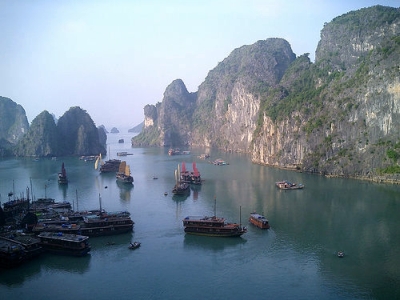
Looking for some ideas for your next trip? Here are 10 must-see spots in Asia as revealed by an insider.
Asia is the ultimate travel destination for the summer: easily accessible, endlessly diverse and comfortably affordable. With exciting cities, scenic splendor, fascinating wildlife, towering monuments and unique festivals, all of your best travel stories are likely to originate here. Just some of the highlights of this incomparable region, from India to Japan, are covered in this short but comprehensive guide.
1) India: Jaisalmer
The interminable bus journey to reach this dauntingly remote corner of India is amply rewarded by the spectacle of Jaisalmer’s vast city wall, with its 99 circular turrets rising dramatically out of the Thar Desert. Once inside the Golden City, look for the havelis, the former mansion houses of rich merchants, with their glorious honeycomb balconies and lattice-work parapets. This is a place to lose yourself in twisting medieval streets, then explore beyond the surrounding sand dunes on a camel trek.
Don’t miss: The ornate gate, complete with Krishna temple, leading to the Gadi Sagar Lake at sunset.
2) Japan: Snow Festivals
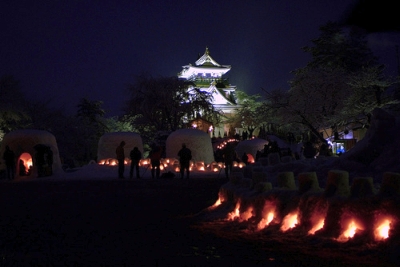 The gigantic snow buildings of Sapporo are the best known, but for a true winter wonderland, seek out the smaller festivals taking place between January and March. At nearby Asahikawa, dozens of dazzling ice sculptures shine with ghostly luminescence in the frigid air; farther south at Yokote, the locals construct 10,000 candlelit kamakura igloos throughout the town. In the highlands of Daisetsuzan National Park, the psychedelic snowscape of Sounkyo is easily the strangest thing you’ll see on your travels.
The gigantic snow buildings of Sapporo are the best known, but for a true winter wonderland, seek out the smaller festivals taking place between January and March. At nearby Asahikawa, dozens of dazzling ice sculptures shine with ghostly luminescence in the frigid air; farther south at Yokote, the locals construct 10,000 candlelit kamakura igloos throughout the town. In the highlands of Daisetsuzan National Park, the psychedelic snowscape of Sounkyo is easily the strangest thing you’ll see on your travels.
Don’t miss: The chance to chisel your own ice block at Tokiwa Park in Asahikawa.
3) Thailand: Ko Samui
Samui may be sneered at by purist travelers, but on its own terms the island is great fun. The beachfront bungalows suit all budgets, and you can stock up on western luxuries before heading up-country to more “authentic” destinations. The nightlife hotspots of Lamai and Chaweng are offset by the tranquil resorts of Maenam and Choeng Mon, the interior is rich with waterfalls and tropical forest, and it’s not every day you get the chance to pray to a mummified monk at Wat Kunaram. Samui is also the jumping-off point for the 42 islands of Angthong marine park.
Don’t miss: The airport — surprising but true: one of the most beautiful in the world.
4) Cambodia: Bokor National Park
While the vast majority of travelers head straight to Angkor Wat, Bokor offers the chance for physically fit (and endlessly patient) jungle trekkers to spot Malayan sun bears, huge hornbills and rhesus monkeys. The flora, including pitcher plants and Venus flytraps, is equally enticing. On the high ground sits the blackened, burnt-out shell of the abandoned Bokor Palace Hotel and Casino (a filming location for many horror flicks). Once the playground of French colonialists, this eerie structure still smolders to this day. Treks from one day to one week are available. For a less demanding adventure, neighboring Ream National Park offers languid long-tail boat rides through miles of mangrove.
Don’t miss: The sound of the jungle by night from a bunk at the National Park Research and Training Facility.
5) Hong Kong
One of the world’s most exciting cities — comprising Hong Kong Island, mainland Kowloon, the New Territories and the outlying islands — is best appreciated in all its illuminated glory from Victoria Peak. Temple Street night market is an intoxicating, if sometimes harrowing experience: think pirate DVDs and fake designer clothes alongside buckets of doomed toads. Find your Taoist fortune at Wong Tai Sin Temple (with its resident soothsayers), gaze up at futuristic architecture and enjoy sensational street food wherever you are.
Don’t miss: The colossal bronze Buddha dominating Lantau Island.
6) Indonesia: Borobudur
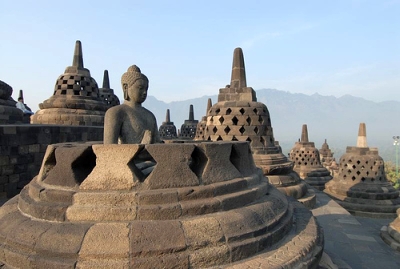 Dramatically ringed by mountains on the island of Java, the monumental temple of Borobudur — the world’s largest Buddhist structure — was swallowed by dense jungle for close to a thousand years. Now restored, the massive, multi-terraced monument reveals to visitors the path to enlightenment: the base section symbolizes the earthly world of desire, the middle division is the transitional sphere and the circular summit symbolizes formless nirvana. At the center of the upper platform stands a mysterious hollow dome, surrounded by 72 stupas in three concentric tiers. Plenty to think about.
Dramatically ringed by mountains on the island of Java, the monumental temple of Borobudur — the world’s largest Buddhist structure — was swallowed by dense jungle for close to a thousand years. Now restored, the massive, multi-terraced monument reveals to visitors the path to enlightenment: the base section symbolizes the earthly world of desire, the middle division is the transitional sphere and the circular summit symbolizes formless nirvana. At the center of the upper platform stands a mysterious hollow dome, surrounded by 72 stupas in three concentric tiers. Plenty to think about.
Don’t miss: The view of smoking volcanoes from the Sphere of Formlessness.
7) Malaysia: Perhentian Islands
Pulau Pangkor on the west coast may have the loveliest sunsets, but the two Perhentian Islands — Besar (Big Island) and Kecil (Small Island) — are the quintessential textbook paradise. With few permanent residents, there are no roads, no nightclubs and you can forget about checking your e-mail. Instead, devote your time to swimming in crystal-clear seas, then eat whatever the fishermen catch that day as your table slowly sinks into the sand. After dark, turtle watching at Three Coves Bay is also worthwhile.
Don’t miss: Scuba diving — there’s no better place to learn.
8) Philippines: Batanes
Closer to Taiwan than Manila, the Philippines’ final frontier is a windswept world unto itself: an island with its own ivatan language, dress and customs, and velvety highlands more reminiscent of Scotland than Asia. The rumble of the ocean is everywhere: this is where the Pacific meets the South China Sea, with churning green waves crashing over serrated volcanic rocks. Ride a motorbike around the grandly named National Road to experience one of the world’s loveliest coastlines, then meet the locals at the Port karaoke bar, the only entertainment for nautical miles.
Don’t miss: The timeless neighboring island of Sabtang, 45 queasy minutes away by falowa boat.
9) Vietnam: Halong Bay
The 2,000-plus limestone outcrops soaring from the emerald waters of Halong Bay form a seascape of otherworldly beauty: 600 square miles of secret coves and echoing grottoes with names like Pelican Cave and Cave of Awe. The islands vary greatly in size; some are mere rocks, others, like Dau Be, have six enclosed lakes. A languid trip around the Bay of the Descending Dragon aboard a traditional junk is the perfect counterpoint to the frenetic pleasures of nearby Hanoi.
Don’t miss: The chance to kayak around your very own island — at least temporarily.
10) Singapore
Sultry Singapore has a reputation for oppressive orderliness — even chewing gum was famously banned — but look closer and a microcosm of the best of Asia emerges. Little India is a heady assault on the senses, Chinatown has streets largely unchanged since the 19th century, the Arab Quarter is an evocative place to haggle for textiles and the Zoological Gardens is a fantastic collection of 240 species separated by moats rather than cages. After that, you’ve earned a Singapore Sling at the Raffles Hotel.
Don’t miss: An evening on Boat Quay, a curving neon strip of thriving restaurants and bars.

About the Author
 Carl Thompson has been writing for travel publications and guidebooks for many years, mainly with the intention of avoiding a proper job. For the full story of a misspent decade, please visit UKTravelWriter.co.uk.
Carl Thompson has been writing for travel publications and guidebooks for many years, mainly with the intention of avoiding a proper job. For the full story of a misspent decade, please visit UKTravelWriter.co.uk.
The post An Insider’s Guide To The Top 10 Destinations In Asia appeared first on The Expeditioner Travel Site.
]]>